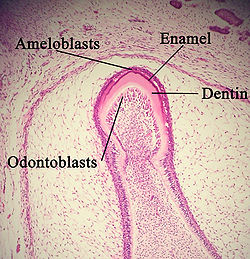- Odontoblast
-
Odontoblast 
A developing tooth with odontoblasts marked. 
The cervical loop area: (1) dental follicle cells, (2) dental mesenchyme, (3) Odontoblasts, (4) Dentin, (5) stellate reticulum, (6) outer enamel epithelium, (7)inner enamel epithelium, (8) ameloblasts, (9) enamel. Latin odontoblastus Code TE E04.0.3.3.1.0.13 In vertebrates, an odontoblast is a biological cell of neural crest origin that is part of the outer surface of the dental pulp, and whose biological function is dentinogenesis, which is the creation of dentin, the substance under the tooth enamel.
Teeth in the molluscan radula are also produced by cells termed "odontoblasts".
Contents
Origin and differentiation
Odontoblasts first appear at sites of tooth development at 17–18 weeks in utero and remain present until death unless killed by bacterial or chemical attack, or indirectly through other means (e.g. being aspirated into dentinal tubules by the use of a turbine handpiece on tooth tissue above). The odontoblasts secrete dentin throughout life (secondary dentin, once root formation is complete), which may be an attempt to compensate for natural wear of the enamel.
Odontoblasts also secrete tertiary dentin when irritated. Tertiary dentin secreted by odontoblasts is often due to chemical attack, either by chemicals diffusing through the dentin and insulting the odontoblasts, or by diffusion of toxic bacterial metabolites down the dentinal tubules in the instance of a carious attack. This tertiary dentin is called reactionary dentin. This is an attempt to slow down the progress of the caries so that it does not reach the pulp. In the case of an infection breaching the dentin to or very near the pulp, or in the instance of odontoblast death due to other attack (e.g. chemical or physical), Pulpal Stem Cells can differentiate into odontoblast-like cells which then secrete the other kind of tertiary dentin, reparative dentin, underneath the site of attack. This is not only to slow the progress of the attack, but also to prevent the diffusion of bacteria and their metabolites into the pulp, reducing the probability of partial pulp necrosis.
The distinction of the two kinds of tertiary dentin is important, because they are secreted by different cells for different reasons. Reactionary dentine is secreted at varying speeds, dependant on the speed of progression of caries above. Histologically, it is easily distinguishable by its disordered tube structure, its local secretion (causing it to protrude into the pulpal cavity) and its slightly lower degree of mineralisation than normal. The tooth is often able to be saved by a simple restoration. Reparative dentine is secreted when the tooth's situation is dire. The odontoblasts are dead, forcing the differentiation of pulpal stem cells into odontoblast-like cells that try desperately to avoid pulpitis.
Morphology
Odontoblasts are large columnar cells arranged in an epithelioid sheet along the junction between dentin and pulp, all the way down to the root apex. It is rich in endoplasmic reticulum and golgi apparatus, especially during primary dentin formation, to give it a high secretory capacity (firstly collagenous matrix to form predentine, then mineral to form the complete dentine). Its nucleus is aligned away from the dentine, with its golgi and ER above it (towards the dentine) reflecting its unidirectional secretion. On initial dentine formation it moves pulpally, away from the primitive amelodentinal junction (then Inner Enamel Epithelium/dental papillary junction) leaving behind a tubular structure known as the odontoblast process. This keeps its tapered structure with cytoskeletal fibres, mainly intermediate filaments. A pulpal A-delta (noxious, short sharp pain) nerve fibre is wrapped around the base of this process, or travels a short way into the dentinal tubule with the odontoblast process (max ~0.1mm) This process lies in a tubule, known simply as a dentinal tubule. In a complete tooth, this process rarely extends beyond 1/3 the depth of the dentine, which is why the odontoblast transduction theory of dentin sensitivity is unlikely. The functions of the odontoblast process are as follows:
1. To aid in the secretion of tubular dentin (dentin surrounding tubule) which further organises and strengthens the dentine as a whole tissue
2. General maintenance of the dentinal tubule and dentinal fluid (ion/protein content etc.)
3. To secrete sclerotic dentin upon carious attack to block off dentinal tubules, slowing the progress of the attack (air space above blockage is known as a dead tract)
4. To channel signals of attack to the odontoblast cell body, initiating reactionary dentin secretion
5. To channel hydrokinetic forces of water movement to the A delta fibre wrapped around its base, maintaining dentine sensitivity
The biological tissue formed by odontoblasts is a type of hard tissue.
It has been shown that odontoblasts secrete the extracellular matrix protein reelin.[1][2][3]
References
- ^ Buchaille R, Couble ML, Magloire H, Bleicher F (September 2000). "A substractive PCR-based cDNA library from human odontoblast cells: identification of novel genes expressed in tooth forming cells". Matrix biology : journal of the International Society for Matrix Biology 19 (5): 421–30. doi:10.1016/S0945-053X(00)00091-3. PMID 10980418. http://linkinghub.elsevier.com/retrieve/pii/S0945-053X(00)00091-3.
- ^ Bleicher F, Couble ML, Buchaille R, Farges JC, Magloire H (August 2001). "New genes involved in odontoblast differentiation". Adv. Dent. Res. 15: 30–3. doi:10.1177/08959374010150010701. PMID 12640735. http://adr.sagepub.com/cgi/pmidlookup?view=long&pmid=12640735.
- ^ Maurin JC, Couble ML, Didier-Bazes M, Brisson C, Magloire H, Bleicher F (August 2004). "Expression and localization of reelin in human odontoblasts". Matrix biology : journal of the International Society for Matrix Biology 23 (5): 277–85. doi:10.1016/j.matbio.2004.06.005. PMID 15464360. http://linkinghub.elsevier.com/retrieve/pii/S0945-053X(04)00081-2.
External links
Tooth development (TE 5.4) -blast General Dental papilla · Epithelial root sheath · Epithelial cell rests of Malassez
Enamel organ: Outer enamel epithelium · Inner enamel epithelium · Stellate reticulum · Stratum intermedium
Dentition · Teething · Tooth eruptionPulp occlusion Canalis amelodentineus · Fovea enamelea · Fovea dentineaHuman cell types / list derived primarily from ectoderm Surface ectoderm Trichocyte · KeratinocyteNeural crest Odontoblast · Cementoblastglia: Schwann cell · Satellite glial cellDigestive systemNeural tube Categories:
Wikimedia Foundation. 2010.
